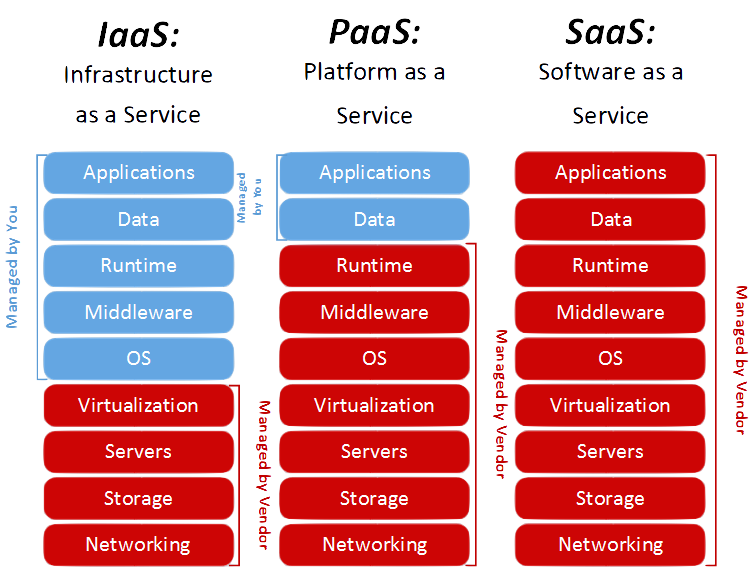
These notes relate to the Cloud Concepts domain of the AWS Certified Cloud practitioner certification and will help you prepare the exam. All of the points covered in these notes are subject to exam questions, so be sure to review them.
About the domain: Cloud Concepts.
this domain covers 26% of the AWS cloud practitioner exam, it targets the following objectives:
- Define the AWS Cloud and its value proposition.
- Identify aspects of AWS Cloud economics.
- List the different cloud architecture design principles.
Types of Cloud Computing:
3 types of cloud computing.
- Infrastructure As A Service (IAAS).
- Platform As A Service (PAAS).
- Software As A Service (SAAS).

Types of Cloud Computing Deployments:
3 types of cloud deployments:
- Public cloud (AWS, Azure, GCP, Alibaba, OCI….).
- Private Cloud (On-premise): you manage it! using, for example, OpenStack, Vmware…
- Hybrid: Mixture of Public and Private.
Community Cloud is another type of deployment model.
The AWS Cloud and its Value Proposition:
Definition of the AWS Cloud:

Amazon Web Services(AWS) is a cloud service from Amazon which provides services in the form of building blocks (services), these building blocks can be used to create and deploy any type of application in the cloud. Each type of service is categorized under a domain, the few domains which are widely used are:
- Compute (contains services such as EC2, ECS, Lambda, Elastic Beanstalk….)
- Storage (contains services such as S3, EBS, Amazon Glacier…)
- Database ( contains services such as Amazon RDS, DynamoDB, Aurora…)
- Migration ( AWS Database Migration Service )
- Network and Content Delivery (VPC, Route 53, CloudFront..)
- Management Tools (Cloudwatch, Cloudtrail, CloudFormation….)
- Security & Identity Compliance ( IAM, KMS, AWS Shield)
- Messaging (SQS, SNS, SES…)
You can access these services via the AWS console at aws.amazon.com or via the Command Line Interface (CLI) or API. the main AWS competitors are Microsoft AZURE and Google Cloud Platform (GCP).
The AWS Value Proposition:
- Trade your capital expense for variable expense.
- Stop spending money running and maintaining data centers.
- Elasticity: Scale on demand, eliminate wasted capacity, go global in minutes.
- Flexibility: Broad set of products.
- Agility: Speed of implementation of services and products.
- Security: Shared responsibility model, AWS has acquired many compliance certifications.
AWS Cloud Economics:
AWS Economics Benefits:
The economic benefits of using AWS services:
- Low Total Cost of Ownership (TCO) as no personal servers needed.
- Save on running and maintaining data centers.
- Billed only for resources subscribed and their length of use, without up-front or long-term commitments.
- Add or remove resources, as per need.
- Centralized Billing and management.
AWS Economics Features:
AWS economics features:
- Pay-As-You-Go: AWS does not require minimum spend commitments or long-term contracts.
- Tiered Pricing: For storage and data transfer, AWS follows a tiered pricing model. The more storage and data transfer you use, the less you pay per gigabyte (Use more, Save more).
- Pay less by using more.
- Save when you reserve.
- Pay less when AWS grows.
AWS Economics Tools:
AWS offers the following tools:
- TCO calculator: Estimates your savings when comparing the cloud to an on-premises or co-location environment.
- Cost Optimization: Provides pre-configured reports for common AWS spend queries for current and historical periods, as well as forecasting.
- Trusted Advisor: Inspects your AWS environment to finds opportunities that can save money, improve system performance, and increase application reliability.
Cloud Architecture Design Principles:
The AWS Well-Architected Framework:
The AWS Well-Architected Framework is based on five pillars:
- Security: The security pillar focuses on protecting information & systems. Key topics include confidentiality and integrity of data, identifying and managing who can do what with privilege management, protecting systems, and establishing controls to detect security events.
- Reliability: The reliability pillar focuses on the ability to prevent, and quickly recover from failures to meet business and customer demand. Key topics include foundational elements around setup, cross project requirements, recovery planning, and how we handle change.
- Performance Efficiency: The performance efficiency pillar focuses on using IT and computing resources efficiently. Key topics include selecting the right resource types and sizes based on workload requirements, monitoring performance, and making informed decisions to maintain efficiency as business needs evolve.
- Cost Optimization: Cost Optimization focuses on avoiding unnecessary costs. Key topics include understanding and controlling where the money is being spent, selecting the most appropriate and right number of resource types, analyzing spend over time, and scaling to meet business needs without overspending.
- Operational Excellence: The operational excellence pillar focuses on running and monitoring systems to deliver business value, and continually improving processes and procedures. Key topics include managing and automating changes, responding to events, and defining standards to successfully manage daily operations.
The AWS design principles:
The below are the AWS design principles:
- Scalability: Systems that are expected to grow over time need to be built on top of a scalable architecture.
- Disposable Resources Instead of Fixed Servers: When designing for AWS, you can take advantage of the dynamically provisioned nature of cloud computing. You can think of servers and other components as temporary resources. You can launch as many as you need, and use them only for as long as you need them.
- Automation: When deploying on AWS, there is an opportunity for automation, so that you improve both your system’s stability and the efficiency of your organization.
- Loose Coupling: As application complexity increases, a desirable attribute of an IT system is that it can be broken into smaller, loosely coupled components. This means that IT systems should be designed in a way that reduces interdependencies—a change or a failure in one component should not cascade to other components.
- Services, Not Servers: AWS offers a broad set of compute, storage, database, analytics, application, and deployment services that help organizations move faster and lower IT costs.
- Databases: With traditional IT infrastructure, organizations are often limited to the database and storage technologies they can use. There can be constraints based on licensing costs and the ability to support diverse database engines. On AWS, these constraints are removed by managed database services that offer enterprise performance at open-source cost.
- Managing Increasing Volumes of Data.
- Removing Single Points of Failure: Production systems typically come with defined or implicit objectives for uptime. A system is highly available when it can withstand the failure of an individual component or multiple components, such as hard disks, servers, and network links.
- Optimize for Cost: When you move your existing architectures into the cloud, you can reduce capital expenses and drive savings as a result of the AWS economies of scale.
- Caching: Caching is a technique that stores previously calculated data for future use. This technique is used to improve application performance and increase the cost-efficiency of an implementation. It can be applied at multiple layers of an IT architecture.
- Security: AWS allows you to improve your security in a variety of ways. AWS is a platform that allows you to formalize the design of security controls in the platform itself. It simplifies system use for administrators and your IT department, and makes your environment much easier to audit in a continuous manner.
Cloud Concepts practice questions:
AWSBOY Cheat sheets:
Notice: we keep updating this material.
You can report a mistake or suggest new notes to add to this AWS Cloud Practitioner Cloud Concepts cheat sheet…let us know in the comment section!
 You need to log in to pass this practice exam.
You need to log in to pass this practice exam.
i really appreciate your help very much and am glad to be part of the family. all i can ask is if it may be possible that the practice exams multiple choices has to be changing in terms of rearrangement when a person is talking the paper for the second time. thank you so much
Awesome! Thanks for this!
I’m starting my AWS cert journey and this is my first ever practice test. It really helps! Thanks for the valuable resources
great!
Great study website. Keep up the good work.
very nice